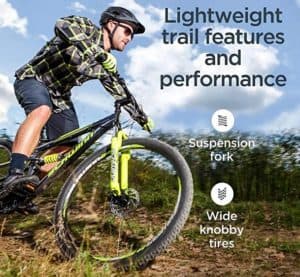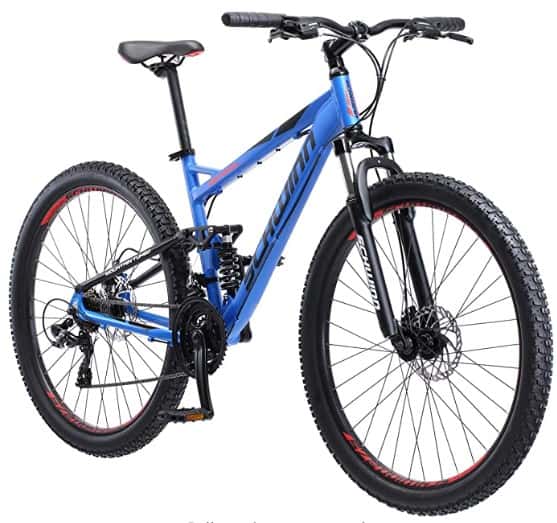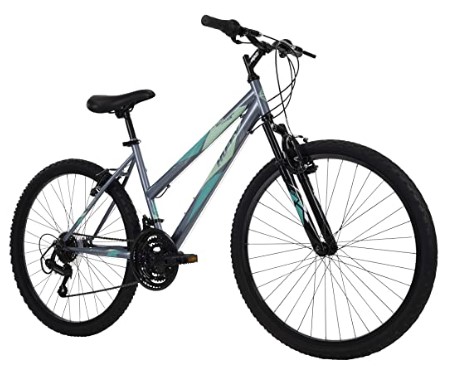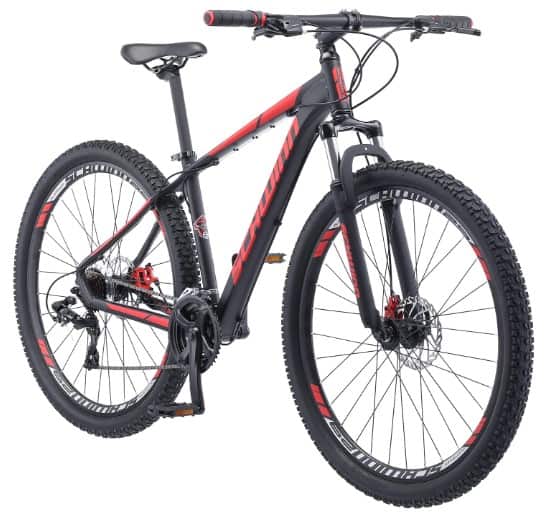Today, two of the most familiar mountain bike types are 29ers and 26ers. So, if you are looking for an MTB to buy, understanding the 29er vs 26er comparison is essential.
Generally, 29ers enjoy more ground traction, rolling resistance, climbing power, speed maintenance, and stability owing to their larger wheels. 26ers, in contrast, have better acceleration, handling, and wheel strength, thanks to their smaller wheel size.
I’ll help you understand these differences to enable you to make a better choice.
Note that I’m talking about the wheel size when referring to these MTBs. In that case, a 29er is a mountain bike featuring 29-inch wheels, while a 26er is a mountain bike featuring 26-inch wheels.
Let’s now compare them in detail.

29er vs 26er: Side by Side Comparison
Let’s look at how these two MTBs compare up close under the following subheadings:
1. Acceleration
A 29er generally has larger wheels which impact its acceleration. Its larger wheels have more mass, which means you’ll need more energy to get the bike moving.
In the long run, it’ll not only cost you more effort but time too to get a 29er up to speed.
In contrast, a 26er is lighter, owing to its smaller wheels. So, you don’t spend so much energy or time accelerating it as you do with a 29er.
Verdict – A 26er is easier to accelerate than a 29er because it has smaller wheels and is lighter. This advantage makes a 26er better for trail riding.
2. Speed Maintenance
While 26ers are better at accelerating, 29ers have the upper hand when maintaining the speed.
Once you get up to speed, a 29er’s larger wheels make it easy to maintain the momentum. That’s because 29ers have more rotating mass.
According to the law of inertia, objects with more mass tend to retain their motion momentum more than those with less mass.
A 29er’s extra mass considerably helps the wheels to maintain their rolling fluency once you pick up speed.
Verdict – A 29er’s added speed makes it better at maintaining high speed.
3. 29 Vs 26 Mountain Bike Weight
It goes without saying; 29ers have heavier wheels than 26ers as their wheels are larger. Usually, wheel mass is directly proportional to wheel weight.
So, if you are looking to save on a few ounces, a 26er is a much better choice.
Verdict – Due to their smaller wheel size, 26ers are slightly lighter.
4. Ground Traction
Ground traction is essential in mountain biking. Generally, the more traction you enjoy, the safer you are.
Good traction translates to speed and safety. It enables you to take on technical sections and corners.
Overall, traction is dependent on tire-to-ground contact. And since 29ers have a larger diameter, they have a larger tire-to-ground surface area, which translates to higher traction.
Nevertheless, this advantage is slim as traction also depends on the tire size (width) and tire pressure.
Verdict – 29ers have a slight advantage when it comes to ground traction.

5. 29er vs 26 Obstacle Rolling
Let’s face it; you expect bigger wheels to roll over obstacles more comfortably than smaller wheels. Well, that’s the case when it comes to 29ers.
Their larger wheels enable them to conquer obstacles easily. Overall, 29ers have a greater attack angle, which allows them to roll over obstacles quickly.
While 26ers can roll over obstacles, they are better at overcoming more minor obstacles.
Verdict – Owing to a greater attack angle, a 29-inch mountain bike is better at rolling over obstacles than a 26er.
6. Climbing Power
If there is a category where there is an undisputed king, it has to be this. The factors discussed above (higher traction, obstacle rolling, and larger wheel diameter) make 29ers better climbers.
As a result, 29ers are better suited for cross country racing as they can comfortably take on hills.
Verdict – 29ers have better climbing power than 26ers owing to better traction and rolling resistance.
7. Bike Handling
A 26er’s lighter weight gives it an advantage here. Usually, it’s easier to maneuver a 26er because of its smaller wheel and mass. While this doesn’t make 29ers awful at handling, you’ll have a comfortable experience with a 26er. That makes 26ers better at maneuvering technical trails.
Verdict – 26ers are much easier to steer, especially technical sections, as their wheels are slightly lighter.
8. 26er vs 29er Wheel Strength
26ers are more popular than 29ers often because they have stronger wheels. These MTBs have smaller wheel diameters, and that means they have shorter spokes.
Usually, shorter spokes are structurally stronger than longer spokes (as it’s the case with 29ers_.
And since a 29er’s wheels are smaller, they rotate closer to the ground, thus stiffer and more robust.
Verdict – 26ers are relatively stronger than their 29ers counterparts, owing to their shorter spokes and smaller diameters.

9. Riding Stability
While it’s easy to assume that 26ers are more stable than 29ers because of their strength advantage, that’s not the case.
As a matter of fact, 29ers are more stable, owing to their larger wheel diameters and more wheel mass.
Typically, the broader and heavier the wheels are, the more stable they are, and that’s the case with 29ers.
29ers generally work hard in maintaining a straight trajectory on challenging trails.
Besides, a 29er’s geometry keeps your body weight in a more balanced position. So, you are less likely to jump off a 29er when you hit a bump.
Verdict – 29ers are more stable than 26ers as they enjoy more rotation mass and larger wheels.
10. 26 Vs 29 Bikes Replacement
Generally, 26ers are as old as the first-ever mountain bike. 29ers, on the other hand, are pretty new, and that makes them less available.
So, when it comes to replacing the wheel, you have a better chance with a 26er than a 29er.
Verdict – It’s easier to replace a 26er than a 29er.
11. User Suitability
Given that 26ers have more climbing power, stability, and obstacle rolling ability, they are an excellent pick for trail riding and cross country racing.
26ers, in contrast, are better for Downhill Mountain biking (DH) and mountain biking packs. That’s thanks to their unmatched handling, stronger wheels, and acceleration.
Is 29er Better than 26 Inch Bike?
There is no better or worse option between 29ers and 26ers as both options have their strength and weakness.
A 29er’s better climbing power, obstacle rolling ability, and stability makes trail riding and cross-country racing better.
Conversely, a 26er’s better handling, acceleration, and strength make it better for downhill and mountain biking packs.

Should You Get a 29er or 26er?
Choosing between a 29er and a 26er depends on your cycling needs, height, and terrain.
In that case, go for a 29er if:
- You are into trail riding or cross-country racing
- Your height is at least 5’9″ (180cm)
- You plan to take on more challenging obstacles
Here are some of the best 29ers:
- Schwinn Bonafide Mountain Bike (Amazon Link) – Best Men’s Hardtail 29er
- Schwinn Traxion Mountain Bike (Amazon Link) – Best Unisex Full Suspension 29er
On the flip side, get a 26er if:
- You are into downhill mountain biking or mountain biking packs
- Your height is more than 5’9″ (180cm)
- You plan to take on terrains with less challenging obstacles
Here are the best 26ers:
- Stone Mountain Women’s Bike (Amazon Link) – Best Women’s Hardtail 26er
- Schwinn Protocol Mountain Bike (Amazon Link) – Best Adult Full Suspension 26er
FAQs
1. Are 26-inch Mountain Bikes Obsolete?
26-inch mountain bikes are still relevant, and they are pretty popular. Essentially, that’s owing to their ease of handling, acceleration superiority, and wheel strength.
Moreover, their wheels are lighter, and that makes the bikes beginner-friendly.
2. Is A 29er Faster Than A 26er?
29ers have larger wheels which are slightly heavier than those of 26ers. So, that makes 26ers better at accelerating. But once you pick up speed, a 29er can maintain it (the speed) much better.
3. What is a 29er Bike Good For?
Due to its better obstacle rolling, stability, and climbing power, a 29er is best for trail riding and XC (cross-country) racing.
4. Can I Convert My 26er to a 29er?
If you have a modifiable full-suspension 26er, it’s possible to convert it into a 29er. Note, however, that such conversions won’t save you money. More importantly, it requires skill and a complete tool kit to do it.
5. Is 26er Still Good?
26ers are still good, especially when mountain biking downhill and taking on mountain bike packs. These MTBs have better handling, wheel strength, and acceleration, making them a worthy investment.
Besides, their replacement parts are more available, which means they are easy to upgrade.
Relevant:
29er vs 26er Mountain Bike: Closing Thought
When it comes to 29ers and 26ers, it’s more about your cycling needs than anything else. While a 26er is best for downhill and mountain biking packs, a 29er is best for trail riding and XC (cross country racing).